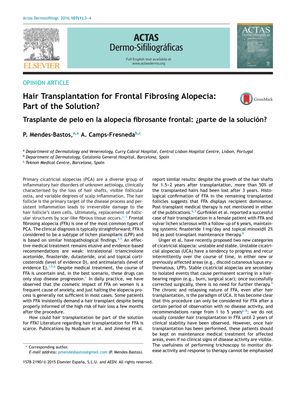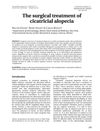Hair Transplantation for Frontal Fibrosing Alopecia: Part of the Solution?
December 2015
in “
Actas Dermo-Sifiliográficas
”
hair transplantation Frontal Fibrosing Alopecia primary cicatricial alopecias hair follicle stem cells inflammation fibrous tissue systemic finasteride topical minoxidil clobetasol propionate lotion topical calcineurin inhibitors anti-inflammatory therapy Propecia Rogaine clobetasol calcineurin inhibitors

TLDR Hair transplantation for Frontal Fibrosing Alopecia may work if the disease is inactive for 2 years and with ongoing treatment to maintain results.
The document discusses the challenges and considerations in using hair transplantation as a treatment for Frontal Fibrosing Alopecia (FFA), a common type of primary cicatricial alopecias (PCA). FFA is characterized by irreversible damage to hair follicle stem cells due to persistent inflammation, leading to hair loss and replacement by fibrous tissue. Medical treatments for FFA have limited effectiveness, and hair transplantation has been considered by some patients. Studies by Nusbaum et al. and Jiménez et al. showed that more than 50% of transplanted hairs were lost after 3 years, indicating that FFA may exhibit recipient dominance. A successful case with 6 years follow-up involved maintenance therapy with systemic finasteride and topical minoxidil. The authors suggest that hair transplantation for FFA should only be considered after a period of no disease activity, recommending a minimum of 2 years of clinical stability. They also emphasize the importance of post-transplant medical therapy to maintain the transplanted hair and prevent disease progression, suggesting maintenance treatments such as clobetasol propionate lotion, topical calcineurin inhibitors, systemic finasteride, and topical minoxidil. Regular follow-up visits and aggressive anti-inflammatory therapy in case of clinical relapse are also recommended. The authors conclude that post-transplant medical therapy is crucial for the success of hair transplantation in FFA patients.











